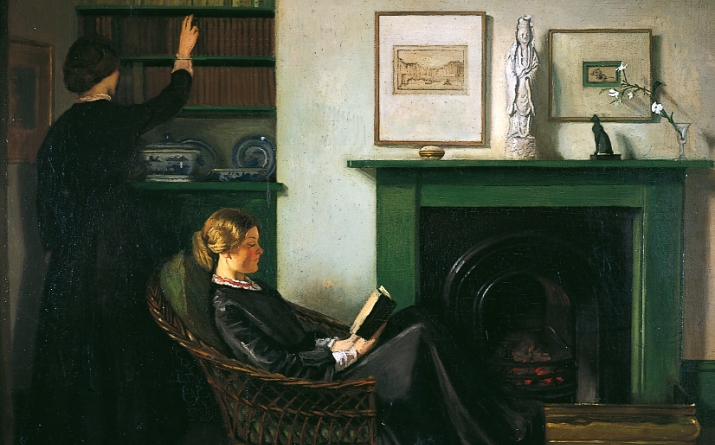We were privileged to be able to work with Dr Samuel Shaw, Post-Doctoral Research Associate at the Yale Center for British Art, on this exhibition. As well as advising on the exhibition and writing the Exhibition Catalogue, (available at Cartwright Hall), he has also written a blog post linked to the Exhibition.
He writes:
The cultural identity of the artist William Rothenstein, the subject of a current exhibition at Cartwright Hall Art Gallery, was a complex one. He was born into the German-Jewish community of Bradford, studied in London and Paris, visited and collected artwork from Spain, Japan and India (among others) and finally settled in Gloucestershire. His role as Principal of the Royal College of Arts from 1920-1935, and the knighthood he received in 1931, led to many people viewing him as one ‘the establishment’ yet his life could also be viewed as one long struggle to belong. At different points in his career, he played up his identity as a Jewish artist, a second-generation German immigrant, a cosmopolitan Londoner, a proud Northerner, and an exemplar of simple rural living in Gloucestershire.
Throughout his career, his art reflected these shifts in his identity. In The Browning Readers (1900), for instance, we are given a view into the artist’s own living room in Kensington, occupied by his new wife, Alice, and her sister Grace. It is, in a sense, an image of life in the artistic middle-classes around the turn of the century: a statement of Rothenstein’s taste and aspirations at a particular point in time. This is who I am, the artist seems to be saying, and this is where I live.

A few years later he started painting in the Jewish East End of London. In a work such as Carrying the Law (1907), we are faced with a very different sort of interior. What Rothenstein found in the East End was unfamiliar to him; it was a type of Jewish experience that he had not seen among the German-Jewish community in Bradford. The Jews of Whitechapel were from Eastern Europe, and were for the most part very poor, and orthodox in their style of worship. Something, however, clearly attracted the artist to their plight, awakening in him a hitherto suppressed interest in his own Jewish identity. This may have been his prompted by his recent marriage and the birth of his children; in any case his representations of their lives speak of his own desire to reconnect with his Jewish roots, and to reconsider his spiritual needs. This is not to say to say that this painting is all about the artist – archival material, however, makes it clear that his paintings of Jewish life should not be considered without due consideration of the artist’s complicated, and ever-changing relationship with his Jewish identity.
Only one major image of Bradford appears in the exhibition: the 1904 painting A Deserted Quarry, which was painted in the summer of 1904, during the great exhibition of Art and Industry that took place in Lister Park. That Rothenstein should have chosen to paint a deserted quarry at this moment seems to speak to his ambivalent relationship with his home city. He spoke, often, of the importance of artists celebrating local spaces – and one might have expected him to paint the mighty mills of central Bradford, if not the warehouse where his father worked. Instead he chose to focus on a site beyond the city centre; a site from which industry has moved on, and where nature has begun to reclaim space, setting as he did curious example for those young artists whom he implored to tackle themes relevant to modern, local life.
Rothenstein’s German identity is perhaps the most difficult to discuss. Though he was not born in Germany, and visited rarely, the culture of his parent’s home country interested him greatly. He was one of the first to protest when the national mood shifted against Germany in the late 1900s, organising an exhibition of contemporary art in 1906 in an attempt to restore good relations between England and Germany. What good came from this exhibition was ruined, however, by the First World War, which forced Rothenstein to downplay this aspect of his identity. While there is no doubt that he was subsequently proud to serve as an English war artist, it is nonetheless interesting to note that the drawings, prints and etchings Rothenstein created at the front focus not on the specificities of the conflict, but on the general destruction caused by the war. Soldiers and weapons are side-lined in favour of blasted trees and the rubble of architecture. The artist eschews brash patriotism in favour of sombre meditation on the ruins of Northern France (ruins he compared to those of ancient India).
Biographical readings of art works are not terribly popular in art-historical circles today – and not without good reason. All paintings, for instance, ought to be considered in their wider social, political, economic and artistic contexts. But this does not mean we should ditch the biographical element altogether, especially when the biography of the artist is as rich and complex as that of William Rothenstein. That he used art as a means of exploring, rehearsing and reshaping his cultural identity continues to be borne out by close study of the objects themselves.